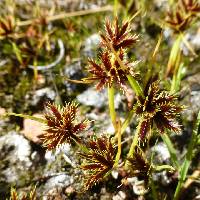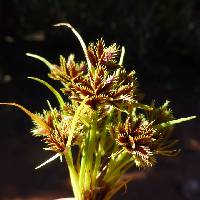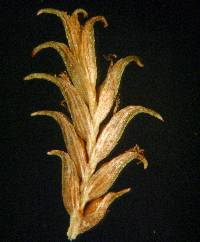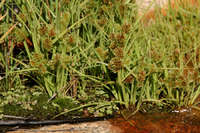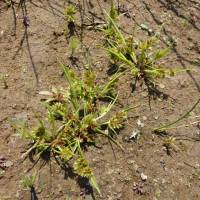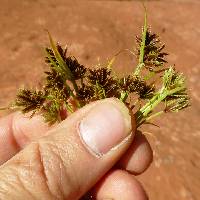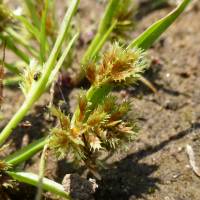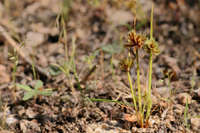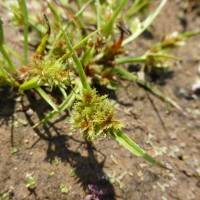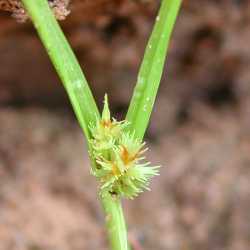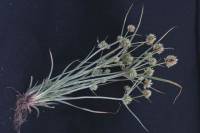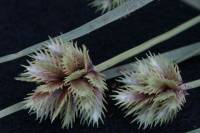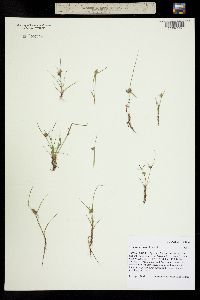Search
View the original page version
Cyperus squarrosus
|
|
|
|
Family: Cyperaceae
bearded flatsedge
[Cyperus aristatus Rottb., nom. superfl., moreCyperus aristatus var. runyonii O'Neill, Cyperus inflexus Muhl., Cyperus squarrosus var. runyonii (O'Neill) S.D.Jones & Wipff] |
Herbs, annual, cespitose, with fibrous roots. Culms 1-20, trigonous, 2-16 cm × 0.5-0.8 mm, glabrous. Leaves 1-3, flat to V-shaped, (1-)5-10(-15) × 0.5-2.5 mm. Inflorescences: spike 1, loosely to densely ovoid to oblong, 6-20(-40) × 9-15(-20) mm; rays absent or 1-3(-6), 4-40 mm; bracts (1-)2-4, longest ± erect, V-shaped, 1-15 cm × 0.5-3 mm; rachilla ± deciduous, wingless. Spikelets (2-)6-20(-40), greenish to reddish brown, somewhat compressed, ovoid-lanceoloid to oblong, 2.5-10(-20) × 1.3-2.2 mm (excluding awns); floral scales deciduous, (4-)10-20(-34), greenish to stramineous or brownish red laterally, greenish medially, (5-)7-9(-11)-ribbed nearly to margins, oblong-lanceolate, (1.2-)1.3-1.8(-2.2) × (0.5-)0.7-0.8(-1) mm, apex cuspidate, excurved awn additional 0.5-1(-1.3) mm. Flowers: stamen 1, filaments 1.5 mm; anthers oblong, 0.2-0.3 mm, connective apex reddish, minute; styles 0.3-0.5 mm; stigmas 0.4-0.7 mm. Achenes light brown to nearly black, stipitate, obovoid (occasionally linear-spatulate or linear oblong, infrequently constricted in middle), 0.7-0.8(-1.1) × (0.2-)0.3-0.4(-0.5) mm, stipe 0.05-0.1 × 0.1 mm, apex truncate, apiculate, surfaces papillose. Fruiting summer. Moist, disturbed soils, gravelly roadsides, flood plains, edges of puddles, muddy places; 0-2500 m; Alta., B.C., Man., N.B., Ont., Que.; Ala., Ariz., Ark., Calif., Colo., Conn., Del., D.C., Fla., Ga., Idaho, Ill., Ind., Iowa, Kans., Ky., La., Maine, Md., Mass., Mich., Minn., Miss., Mo., Mont., Nebr., Nev., N.H., N.J., N.Mex., N.Y., N.C., N.Dak., Ohio, Okla., Oreg., Pa., R.I., S.C., S.Dak., Tenn., Tex., Utah., Vt., Va., Wash., W.Va., Wis., Wyo.; Mexico; West Indies; Bermuda; Central America; South America; Eurasia; Africa; Atlantic Islands; Indian Ocean Islands; Pacific Islands; Australia. Cyperus squarrosus can be recognized by its small size and annual habit combined with its oblong-lanceolate floral scales bearing five to eleven conspicuous ribs and excurved awns. Some collections have been misidentified as C. acuminatus, an annual species of subg. Pycnostachys that has ovate-lanceolate, three-ribbed floral scales and digitately clustered spikelets.
Annual herb with fibrous roots, tufted 2 - 16 cm tall Leaves: one to three, basal, alternate, 0.5 - 1 cm long, 0.5 - 2.5 mm wide, flat or V-shaped in cross-section, linear, parallel-veined, keeled beneath, with a sheathing base that encloses the stem. Inflorescence: a single terminal spike, 0.5 - 2 cm long, 9 - 15 mm wide, loosely to densely egg-shaped or oblong, consisting of six to twenty spikelets, subtended by spirally arranged leafy bracts. Bracts two to four, more or less upright, unequal, 1 - 15 cm long, 0.5 - 3 mm wide, all or some much longer than the inflorescence, V-shaped in cross-section. Rays (branches of inflorescence) zero or one to three, 0.5 - 4 cm long. Flowers: minute, in the axil of a floral scale, lacking sepals and petals. Stamen one, exserted, about 1.5 mm long. Anther under 0.5 mm long. Pistil one. Style and stigma about 0.5 mm long. Fruit: a one-seeded achene, short-stalked, light brown to almost black, to about 1 mm long and 0.5 mm wide, usually egg-shaped with a flat apex bearing a short point, three-angled, bumpy. Seed with a thin, non-adherent wall. Spikelets: greenish to reddish brown, 2.5 - 10 mm long, 1 - 2.5 mm wide, somewhat flattened, egg- lance-shaped to oblong, subtended by two small bracts, with ten to twenty floral scales. Scales greenish down the middle, greenish to straw-colored or reddish brown along the sides, about 1.5 mm long and 0.5 mm wide, narrowly lance-shaped with a pointed apex bearing a 0.5 - 1 mm long bristle, seven- to nine-ribbed, lowest one empty. Culms: one to twenty, 2 - 16 cm long, about 0.5 mm wide, triangular in cross-section, solid. Similar species: No information at this time. Flowering: mid-July to late September Habitat and ecology: Mud and gravel bars in streams and in ditches. Occurence in the Chicago region: native Etymology: Cyperus is the ancient Greek word for sedge. Squarrosus means "having parts that are spreading or recurved at the ends." Author: The Morton Arboretum Slender, tufted, sweet-scented annual 0.5-2 dm; lvs few, all borne near the base, mostly 0.5-2(-2.5) mm wide, up to as long as or a little longer than the stems; invol bracts elongate, some or all of them much surpassing the infl; spikelets in dense, capitate clusters, the terminal cluster sessile, the others (if present) on slender rays to 3 cm; spikelets 4-10 mm, flattened, 6-20-fld; scales evidently (5)7-9-nerved, 1.0-1.7 mm exclusive of the recurved, slender awn-tip, this 0.3-1 mm; rachilla wingless, ±persistent, the scales falling from it at maturity; stamen 1; anthers 0.2-0.3 mm; achenes trigonous, 0.6-1 mm; 2n=48, 56, 64. Moist or wet, often sandy soil; nearly cosmop., and throughout our range. (C. aristatus; C. inflexus) Gleason, Henry A. & Cronquist, Arthur J. 1991. Manual of vascular plants of northeastern United States and adjacent Canada. lxxv + 910 pp. ©The New York Botanical Garden. All rights reserved. Used by permission. FNA 2002, Tucker 1994 Common Name: bearded flatsedge Duration: Annual Nativity: Native Lifeform: Graminoid General: Caespitose annual 2-16 cm tall, without rhizomes but with fibrous roots. Vegetative: Culms 0.5-1 mm in diameter, three ranked; 1-3 leaves, 5-10 mm long, 0.5-2.5 mm wide, flat to v-shaped, margins smooth. Inflorescence: Bracts 2-4, 1-15 cm long, 0.5-3 mm wide, v-shaped, margins and keels smooth or sparsely rough to the touch, the longest more or less erect, other oblique; spikes 6-20 mm long, 9-15 mm wide, loosely to densely ovoid to oblong, compressed, zigzag, reddish brown; greenish to brownish red; scales deciduous 10-20, 1-2 mm long, oblong-lanceolate, 7-9 nerved nearly to margins. Ecology: Found on disturbed soils, gravelly roadsides, floodplains, mud places from sea level to 8,000 ft (2438 m); flowers July-November. Distribution: Throughout N. Amer and in every state in the US; south through MEX to s S. Amer.; also in Africa, Asia and Australia. Notes: Distinguished its small size, annual habit; ability to grow in the uplands or wet areas; and its oblong-lanceolate floral scales bearing five to eleven conspicuous and excurved awns. Ethnobotany: The tubers were eaten as food. Etymology: Cyperus is from the Greek word meaning sedge, while squarrosus means either scaly or rough. Synonyms: Cyperus aristatus, Cyperus aristatus var. runyonii, Cyperus inflexus, Cyperus squarrosus var. runyonii Editor: SBuckley 2010, FSCoburn 2015 |
|
|
|


